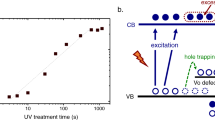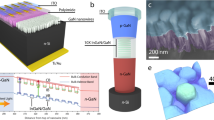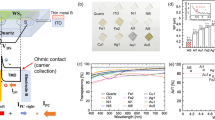Abstract
Thin layers of indium tin oxide are widely used as transparent coatings and electrodes in solar energy cells1, flat-panel displays2,3, antireflection coatings4, radiation protection5 and lithium-ion battery materials6, because they have the characteristics of low resistivity, strong absorption at ultraviolet wavelengths, high transmission in the visible7, high reflectivity in the far-infrared and strong attenuation in the microwave region. However, there is often a trade-off between electrical conductivity and transparency at visible wavelengths for indium tin oxide and other transparent conducting oxides. Here, we report the growth of layers of indium tin oxide nanowires that show optimum electronic and photonic properties and demonstrate their use as fully transparent top contacts in the visible to near-infrared region for light-emitting devices.
This is a preview of subscription content, access via your institution
Access options
Subscribe to this journal
Receive 12 print issues and online access
$259.00 per year
only $21.58 per issue
Buy this article
- Purchase on Springer Link
- Instant access to full article PDF
Prices may be subject to local taxes which are calculated during checkout




Similar content being viewed by others
References
Ginely, D. S. & Bright, C. Transparent conducting oxides. MRS Bull. 25, 15–65 (2000).
Wan, Q. et al. High-performance transparent conducting oxide nanowires. Nano Lett. 6, 2909–2915 (2006).
Sawada, M., Higuchi, M., Kondo, S. & Saka, H. Characteristics of indium-tin-oxide/silver/indium-tin-oxide sandwich films and their application to simple-matrix liquid-crystal displays. Jpn J. Appl. Phys. 40, 3332–3336 (2001).
Kim, H., Horwitz, J. S., Kim, W. H., Kafafi, Z. H. & Chrisey, D. B. Highly oriented indium tin oxide films for high efficiency organic light-emitting diodes. J. Appl. Phys. 91, 5371–5376 (2002).
Synowicki, R. A., Hale, J. S., Ianno, N. J. & Woollam, J. A. Low earth orbit effects on indium tin oxide and polyester and comparison with laboratory simulations. Surf. Coat. Technol. 62, 499–503 (1993).
Kim, D.-W. et al. Highly conductive coaxial SnO2–In2O3 heterostructured nanowires for Li ion battery electrodes. Nano Lett. 7, 3041–3045 (2007).
Granqvist, C. G. & Hultåker, A. Transparent and conducting ITO films: new developments and applications. Thin Solid Films 411, 1–5 (2002).
Cui, Y. & Lieber, C. M. Functional nanoscale electronic devices assembled using silicon nanowire building blocks. Science 291, 851–853 (2006).
Hsu, Y.-J. & Lu, S.-Y. Vapor–solid growth of Sn nanowires: Growth mechanism and superconductivity. J. Phys. Chem. B 109, 4398–4403 (2005).
Zhou, J. et al. Vertically aligned Zn2SiO4 nanotube/ZnO nanowire heterojunction arrays. Small 3, 622–626 (2007).
Lu, J. G., Chang, P. & Fan, Z. Quasi-one-dimensional metal oxide materials—Synthesis, properties and applications. Mater. Sci. Eng. R 52, 49–91 (2006).
Johnson, M. C., Aloni, S., McCready, D. E. & Bourret-Courchesne, E. Controlled vapour–liquid–solid growth of indium, gallium and tin oxide nanowires via chemical vapor transport. Cryst. Growth Des. 6, 1936–1941 (2006).
Nguyen, P. et al. Epitaxial directional growth of indium-doped tin oxide nanowire arrays. Nano Lett. 3, 925–928 (2003).
Xiang, J. et al. Ge/Si nanowire heterostructures as high-performance field-effect transistors. Nature 441, 489–493 (2006).
Law, M., Greene, L. E., Johnson, J. C., Saykally, R. & Yang, P. D. Nanowire dye-sensitized solar cells. Nature Mater. 4, 455–459 (2005).
Dattoli, E. N. et al. Fully transparent thin-film transistor devices based on SnO2 nanowires. Nano Lett. 7, 2463–2469 (2002).
Wang, D. L. & Lieber, C. M. Inorganic materials: Nanocrystals branch out. Nature Mater. 2, 355–356 (2003).
van der Pauw, L. J. A method of measuring specific resistivity and Hall effect of discs of arbitrary shape. Philips Res. Repts. 13, 1–9 (1958).
Wan, Q., Feng P. & Wang T. H. Vertically aligned tin-doped indium oxide nanowire arrays: Epitaxial growth and electron field emission properties. Appl. Phys. Lett. 89, 123102 (2006).
Zhang, L., Tu, R. & Dai, H. J. Parallel core–shell metal–dielectric–semiconductor germanium nanowires for high-current surround-gate field-effect transistors. Nano Lett. 6, 2785–2789 (2006).
Nguyen, P. et al. Direct integration of metal oxide nanowire in vertical field-effect transistor. Nano Lett. 4, 651–657 (2004).
Ju, S. et al. Fabrication of fully transparent nanowire transistors for transparent and flexible electronics. Nature Nanotech. 2, 378–384 (2007).
Kim, J. K. et al. Light extraction enhancement of GaInN light emitting diodes by graded refractive index indium tin oxide anti-reflection contact. Adv. Mater. 20, 801–804 (2008).
Weber, J. & Alonso, I. Near-band-gap photoluminescence of Si–Ge alloys. Phys. Rev. B 40, 5683–5693 (1989).
Schnitzer, I., Yablonovitch E., Caneau, C., Gmitter, T. J. & Scherer, A. 30% external quantum efficiency from surface textured, thin-film light-emitting diodes. Appl. Phys. Lett. 63, 2174–2176 (1993).
Acknowledgements
The authors acknowledge support from Science Foundation Ireland (02/IN.1/172) and the EU Network of Excellence nanoPhotonics to Realise Molecular Scale Technologies (PhOREMOST) (FP6/2003/IST/2-511616). V.L. thanks the Programa Bicentenario de Cienca y Tecnología (PBCT), Chile (ACT027) and Conselho Nacional de Desenvolvimento Cientifico e Tecnologico (CNPq), Brazil. We also acknowledge the contributions of N. Roos and T. P. Sidiki to the design of the MBE reactor, and thank A. C. Martín (Consejo Superior de Investigaciones Cientificas, CSIC) for MBE deposition of Ti/Pt/Au bottom contacts on selected samples, and D. Lebedev (University of Wuppertal) for ellipsometric characterization. We also thank C. Gergely and P. Arcade (Université Montpellier II) for access to their far-infrared spectrometer.
Author information
Authors and Affiliations
Contributions
C.O.D., M.S. and C.M.S.T. conceived and designed the experiments and analyses. C.O.D., M.S. and G.V. performed the experiments. C.O.D., M.S., G.V. and V.L. analysed the data. S.B.N. conducted part of the TEM analysis and C.M.S.T. supervised the work. All authors discussed the results and C.O.D. wrote the manuscript.
Corresponding authors
Supplementary information
Supplementary Information
Supplementary Information (PDF 8389 kb)
Rights and permissions
About this article
Cite this article
O'Dwyer, C., Szachowicz, M., Visimberga, G. et al. Bottom-up growth of fully transparent contact layers of indium tin oxide nanowires for light-emitting devices. Nature Nanotech 4, 239–244 (2009). https://doi.org/10.1038/nnano.2008.418
Received:
Accepted:
Published:
Issue Date:
DOI: https://doi.org/10.1038/nnano.2008.418
This article is cited by
-
Two quasi-interfacial p-n junctions observed by a dual-irradiation system in perovskite solar cells
npj Flexible Electronics (2023)
-
Optical transmittance and electrical transport investigations of Fe-doped In2O3 thin films
Applied Physics A (2021)
-
Gas-sensing properties of ITO materials with different morphologies prepared by sputtering
SN Applied Sciences (2020)
-
Electro-Optical Properties of Low-Temperature Growth Indium-tin-oxide Nanowires Using Polystyrene Spheres as Catalyst
Nanoscale Research Letters (2016)
-
Electrical, structural, and optical properties of sulfurized Sn-doped In2O3 nanowires
Nanoscale Research Letters (2015)



